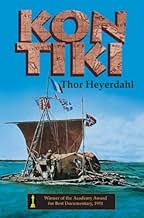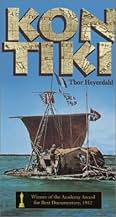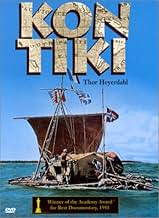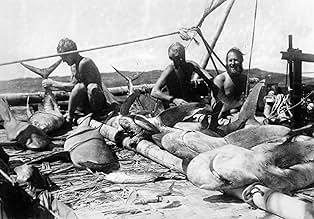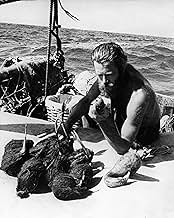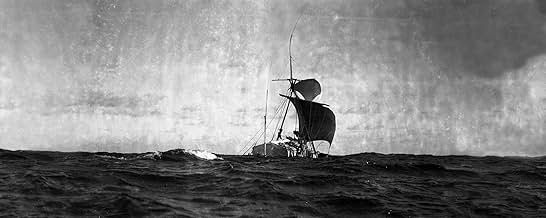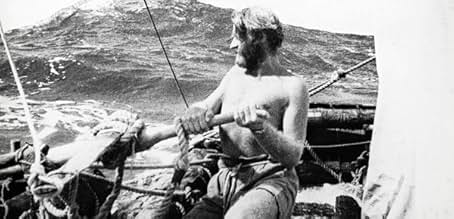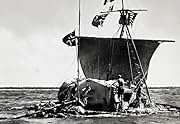NOTE IMDb
7,9/10
2,9 k
MA NOTE
Ajouter une intrigue dans votre langueA documentary about the Kon-Tiki expedition of the Norwegian explorer Thor Heyerdahl.A documentary about the Kon-Tiki expedition of the Norwegian explorer Thor Heyerdahl.A documentary about the Kon-Tiki expedition of the Norwegian explorer Thor Heyerdahl.
- Réalisation
- Scénario
- Casting principal
- Récompensé par 1 Oscar
- 2 victoires et 1 nomination au total
Avis à la une
Very well done film documenting the ultimate adventure. Heyerdahl and his team sail across the Pacific ocean on a wooden raft to prove the thesis that South American Indians took the same route and settled in the Polynesian Islands, long before Columbus discovered America. I'm curious to know where Heyerdahl's thesis stands today. The documentary is pretty good, considering the limited equipment that the crew had to work with. It's nevertheless riveting most of the time. I would be scared to death to be in the unknown like they were. At the same time, it's the ultimate adventure!
Seen at home, in Toronto, on April 26th, 2005.
87/100 (***½)
Seen at home, in Toronto, on April 26th, 2005.
87/100 (***½)
I got a book that went along with the film to for Christmas in '75. It was quite informative, reminded me very much of the National Geographic type things that you see around too. No idea of Heyerdahl's 'Incans traded with /moved to Polynesia' thesis holds any water, but it's certainly worth yer while. Food for thought if nothing else.
When I was a youth I was interested in anthropology and exploring. The searching and thrill of tracing in the footsteps of explorers was exciting. I read books about such adventures and searches for lost civilizations. In the mid-1950s, I read Thor Heyerdahl's "Kon-Tiki: Across the Pacific in a Raft." It was a gripping tale of a real-life adventure.
With Kon-Tiki, Thor Heyerdahl did something that no one else had ever done. That is, that no one had done before in recorded history. But he thought it was not only possible but probable. Having researched and studied civilizations in South America and the Polynesian Islands, Heyerdahl found some striking similarities. He conjectured that some of the South Pacific islands may have been settled by people who sailed there from Peru. So, in 1947, he set out with five companions to prove that such a sea voyage would have been possible 1,500 years ago.
The Kon-Tiki expedition built a raft out of huge balsa logs and native plants that they cut and gathered themselves in South America. On April 28, their voyage began, and 101 days later they landed on a small island of the Tuamotus in French Polynesia. They had sailed and drifted 5,000 miles (4,300 nautical miles) across the Pacific Ocean. They proved that it could be done. Most of the later research and studies have established a strong link of the South Pacific Islands with migrations from Asia. But there still remains the possibility that some people may have crossed the ocean from South America.
In 1955, when I read Heyerdahl's 1948 book about the adventure, I didn't know that this 1950 movie had been made about the voyage. Let's face it - documentary films have never been big draws or appealed to widespread audiences. It had very limited release in the U. S. but was highly popular in Norway and the rest of Europe And, 1950 was before videos or DVDs were available that the public could buy. The film won a 1951 Oscar for documentary in 1952, but the Oscar shows only cover the main Oscar winners for feature films. Years later I came across this film and just watched it again recently.
The wonder of this film is that it is actual film footage that Heyerdahl and company shot on the expedition. There's no doctoring, no Hollywood glamorizing, no fiction or spin in this film. It's a 77-minute narrated story with actual film footage of the expedition. Heyerdahl himself narrates the film - in both the Scandinavian and English versions that were filmed simultaneously. He gives a very brief background leading up to the plans for the expedition. Then the film shows some of the team's actual logging of large balsa trees for the raft. It shows the men working on and building the raft in the port of Callao, Peru. The bulk of the film time is given to the actual voyage.
A 2012 European feature film was made on the Kon-Tiki expedition - after all the members had died. It deviated some from the factual details but generally told the story of the venture. And the filming of the ocean scenes near Malta gave an authentic look to the film. But, the greater emphasis on the struggles, inclement weather, dangers and drama are clear for greater interest and appeal. The one benefit of the later feature film was its information about the individual members of the crew. The documentary didn't spend time giving the backgrounds or information about the crew. All of that had been well covered in the news media and press leading up to the 1947 venture.
I found some of the information Heyerdahl gave in his narrating the film to be very interesting. For instance, he said that they never sighted a single ship during their entire voyage. I'm not familiar with commercial shipping lanes or ocean fishing grounds. And, the Pacific Ocean covers the largest area of any body of water or land mass on the face of the earth. But they had almost constant clear weather. With thousands of ships plying the earth's oceans, the height of ships above the water, and a visibility of a hundred miles or more, it's a wonder that they never so much as spotted a ship on the distant horizon.
Heyerdahl says, ""The experts had been quite wrong when they maintained that the ropes of the balsa raft would be chafed right through. The ropes, being harder than balsa, would dig deeper and deeper into the logs until they were completely protected in deep grooves."
Their average daily speed was 42.5 miles, and their longest 24-hour period covered about 80 miles. They were constantly followed by sharks. They caught and ate sharks and other fish - their favorite being the dolphin fish. Every morning they would collect the flying fish that were on the deck and eat them for breakfast. They used cuttle fish for ink. They were never attacked by sharks or whales. The current and Tradewinds carried them constantly Westward. These were so strong, that they had to tether their small dingy to the raft when one or two men got in it to film the raft at sea. The first time they sighted land, they tried to steer toward it but to no avail. At one point, Heyerdahl says, "We had drifted automatically a fifth of the way around the globe in a Westerly direction; but working our way a mere 200 yards in the opposite direction proved impossible."
This is an interesting film of a real event that people of all ages and time should enjoy. Especially those who enjoy adventure and exploring.
With Kon-Tiki, Thor Heyerdahl did something that no one else had ever done. That is, that no one had done before in recorded history. But he thought it was not only possible but probable. Having researched and studied civilizations in South America and the Polynesian Islands, Heyerdahl found some striking similarities. He conjectured that some of the South Pacific islands may have been settled by people who sailed there from Peru. So, in 1947, he set out with five companions to prove that such a sea voyage would have been possible 1,500 years ago.
The Kon-Tiki expedition built a raft out of huge balsa logs and native plants that they cut and gathered themselves in South America. On April 28, their voyage began, and 101 days later they landed on a small island of the Tuamotus in French Polynesia. They had sailed and drifted 5,000 miles (4,300 nautical miles) across the Pacific Ocean. They proved that it could be done. Most of the later research and studies have established a strong link of the South Pacific Islands with migrations from Asia. But there still remains the possibility that some people may have crossed the ocean from South America.
In 1955, when I read Heyerdahl's 1948 book about the adventure, I didn't know that this 1950 movie had been made about the voyage. Let's face it - documentary films have never been big draws or appealed to widespread audiences. It had very limited release in the U. S. but was highly popular in Norway and the rest of Europe And, 1950 was before videos or DVDs were available that the public could buy. The film won a 1951 Oscar for documentary in 1952, but the Oscar shows only cover the main Oscar winners for feature films. Years later I came across this film and just watched it again recently.
The wonder of this film is that it is actual film footage that Heyerdahl and company shot on the expedition. There's no doctoring, no Hollywood glamorizing, no fiction or spin in this film. It's a 77-minute narrated story with actual film footage of the expedition. Heyerdahl himself narrates the film - in both the Scandinavian and English versions that were filmed simultaneously. He gives a very brief background leading up to the plans for the expedition. Then the film shows some of the team's actual logging of large balsa trees for the raft. It shows the men working on and building the raft in the port of Callao, Peru. The bulk of the film time is given to the actual voyage.
A 2012 European feature film was made on the Kon-Tiki expedition - after all the members had died. It deviated some from the factual details but generally told the story of the venture. And the filming of the ocean scenes near Malta gave an authentic look to the film. But, the greater emphasis on the struggles, inclement weather, dangers and drama are clear for greater interest and appeal. The one benefit of the later feature film was its information about the individual members of the crew. The documentary didn't spend time giving the backgrounds or information about the crew. All of that had been well covered in the news media and press leading up to the 1947 venture.
I found some of the information Heyerdahl gave in his narrating the film to be very interesting. For instance, he said that they never sighted a single ship during their entire voyage. I'm not familiar with commercial shipping lanes or ocean fishing grounds. And, the Pacific Ocean covers the largest area of any body of water or land mass on the face of the earth. But they had almost constant clear weather. With thousands of ships plying the earth's oceans, the height of ships above the water, and a visibility of a hundred miles or more, it's a wonder that they never so much as spotted a ship on the distant horizon.
Heyerdahl says, ""The experts had been quite wrong when they maintained that the ropes of the balsa raft would be chafed right through. The ropes, being harder than balsa, would dig deeper and deeper into the logs until they were completely protected in deep grooves."
Their average daily speed was 42.5 miles, and their longest 24-hour period covered about 80 miles. They were constantly followed by sharks. They caught and ate sharks and other fish - their favorite being the dolphin fish. Every morning they would collect the flying fish that were on the deck and eat them for breakfast. They used cuttle fish for ink. They were never attacked by sharks or whales. The current and Tradewinds carried them constantly Westward. These were so strong, that they had to tether their small dingy to the raft when one or two men got in it to film the raft at sea. The first time they sighted land, they tried to steer toward it but to no avail. At one point, Heyerdahl says, "We had drifted automatically a fifth of the way around the globe in a Westerly direction; but working our way a mere 200 yards in the opposite direction proved impossible."
This is an interesting film of a real event that people of all ages and time should enjoy. Especially those who enjoy adventure and exploring.
10defdewd
The tweedy professor-types thought they had it all figured out. Today's peoples who inhabit Polynesia descended from migratory Asians, intrepidly moving from the Far East, island to island, eastward into Tahiti and all the other exotic tropic isles of the South Pacific over thousands of years. But the established thinking just didn't sit well with young Norwegian ethnographer Thor Heyerdahl. If that explanation were true, how come some folks born and bred in those islands have traditions, artwork, and physical features resembling not those from Asia, but South America? How can the vegetation of Ecuador, Peru and Chile look so much like what you'd find on the island several thousand miles away? Is it just a coincidence that the Islanders point out to sea in the direction of South America and say that is where their ancestors came from, led by Tiki, their equivalent of Adam? Meanwhile, how is it Norwegians speak of Scandanavian forerunners who were chased from the South American continent they had colonized, and, together with some of the native peoples they befriended, set off over the sea -- heading WEST? It's all too much to be a coincidence to Heyerdahl. With an amazing amount of moxie, a handful of crewmen, and the local know-how for traditional raft-building, an expedition begins. It's as much a trip into the human imagination as it is a pseudo-scientific demonstration that such a journey is possible with only the very basics of tools and seamanship. The Oscar-winning documentary may be dated in its tone and Anglo-ethnocentric approach, but it soars with a spirit of adventure besting even the space program that launched a decade later, as men are willing to risk it all to test a theory they think is true. Wonderful. Do yourself a favor and read the book first. It is an amazing page-turner and the perfect setup for the newsreel-style movie.
Although the 2012 Dramatization of this event was very good (see my review), the documentary is even more fascinating. There is nothing like real-life documentation to involve you emotionally to be vested in a good film. And this documentary deserved its Academy Award for Best Documentary of 1950. Nothing was even close to this film.
Thor Heyerdahl made the best sea adventure documentary of all time with this piece. The trip itself makes Columbus and Leif Erikson look like sissies compared to this adventure. Heyerdahl made the trip exactly as Tiki, the ancient Peruvian did, over 1500 years ago. A fascinating piece.
Thor Heyerdahl made the best sea adventure documentary of all time with this piece. The trip itself makes Columbus and Leif Erikson look like sissies compared to this adventure. Heyerdahl made the trip exactly as Tiki, the ancient Peruvian did, over 1500 years ago. A fascinating piece.
Le saviez-vous
- AnecdotesAt the point of 2010, no one of the Kon-Tiki's members still alive: Torstein Raaby died in 1964 in Greenland by heart condition while he trying to get North Pole (he was 45). Erik Hesselberg died in 1972 in Larvik, Norway, by heart condition (he was 58). Herman Watzinger died in 1986 in Peru by natural causes (he was 70). Bengt Danielsson died in 1997 in Tahiti, by deterioration in his health (he was 75). Thor Heyerdahl died in 2002 in Colla Micheri, Italy, by a brain tumor (he was 87). Finally, Knut Haugland died in 2009 in Oslo, Norway, by natural causes (he was 92).
- ConnexionsEdited into Thor Heyerdahl - en oppdagelsesreisende i vår tid (1984)
Meilleurs choix
Connectez-vous pour évaluer et suivre la liste de favoris afin de recevoir des recommandations personnalisées
- How long is Kon-Tiki?Alimenté par Alexa
Détails
- Date de sortie
- Pays d’origine
- Site officiel
- Langue
- Aussi connu sous le nom de
- Kon-Tiki
- Lieux de tournage
- Sociétés de production
- Voir plus de crédits d'entreprise sur IMDbPro
- Durée1 heure 17 minutes
- Couleur
- Mixage
- Rapport de forme
- 1.37 : 1
Contribuer à cette page
Suggérer une modification ou ajouter du contenu manquant

Lacune principale
By what name was L'expédition du Kon-Tiki (1950) officially released in India in English?
Répondre
